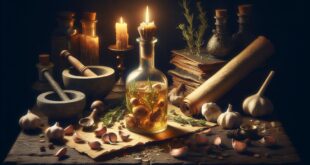 Viking warriors didn’t just rely on brute force and skill with a sword—they had an edge rooted in nature. Plants, roots, and fungi played a key role in their physical endurance, allowing them to push through exhaustion and recover faster than their enemies. While we often picture them as relentless raiders fueled by sheer aggression, their strength was as much about strategy as it was about muscle. And Viking medicine? It was surprisingly advanced.
Viking warriors didn’t just rely on brute force and skill with a sword—they had an edge rooted in nature. Plants, roots, and fungi played a key role in their physical endurance, allowing them to push through exhaustion and recover faster than their enemies. While we often picture them as relentless raiders fueled by sheer aggression, their strength was as much about strategy as it was about muscle. And Viking medicine? It was surprisingly advanced.
One of their most prized plants was Rhodiola rosea, a hardy herb that thrived in the harsh Scandinavian terrain. Known today as an adaptogen, it helped the body resist physical and mental stress. The Vikings likely chewed its roots before long voyages or battles, using it to fight fatigue and sharpen their focus. Studies now confirm what they probably knew instinctively—Rhodiola can improve endurance, reduce stress hormones, and even enhance reaction time. A warrior’s worst enemy wasn’t just the opponent in front of him, but the creeping exhaustion that dulled his senses and slowed his sword.
Then there was Angelica archangelica, a towering plant with feathery leaves that found its way into Viking herbal strength regimens. It wasn’t just a common pantry item—it was a commodity, traded like silver in northern markets. Some sources suggest they boiled its root into tonics to boost stamina, while the Sami people, who lived alongside the Norse, believed it strengthened the body against illness. Could the Vikings have harnessed its immune-boosting properties before grueling campaigns? It’s more than likely.
Mushrooms also played a role, though not always in ways you’d expect. Fly agaric (Amanita muscaria), the striking red-capped fungus dotted with white spots, has long been associated with shamanic rituals. While there’s debate over whether Viking berserkers used it to enter their legendary battle rages, it’s clear that certain fungi had medicinal and stimulating effects. Some historians suggest they preferred Chaga (Inonotus obliquus), a charcoal-like mushroom that grows on birch trees. Rich in antioxidants, it could have helped with recovery from wounds and inflammation. If modern athletes use anti-inflammatory supplements to speed up healing, why wouldn’t Viking warriors have done the same—just with different tools?
Of course, herbal strength wasn’t just about energy boosts—it was about resilience. The frigid Nordic climate was unforgiving, sapping energy and testing the limits of human endurance. Yet these warriors lasted through brutal winters, fought in chilling sea winds, and still had strength left to conquer distant shores. Some speculate that knotgrass and nettle were part of their diet, packed with iron and minerals to keep their blood strong and bones unyielding.
It’s fascinating to think about: while we now turn to protein shakes and electrolytes, Vikings relied on the land to fuel their bodies. Maybe they didn’t have labs or clinical trials, but they knew—from trial, error, and survival. Hemingway once said, “The world breaks everyone, and afterward, many are strong at the broken places.” For Vikings, the difference between weakness and strength might have been a handful of roots, a bitter tonic, or a carefully prepared mushroom brew.
Healing remedies in Viking herbal medicine
When wounds ran deep and sickness threatened their survival, Viking medicine leaned on the forest, the earth, and the sea. Their healers—whether wise women, volva (seeresses), or battle-hardened warriors themselves—knew that survival depended on more than just strength. They used plants, roots, and even animal-derived concoctions to stitch up the fallen and restore those who could still fight. While modern medicine has its sterile instruments and pharmaceuticals, Viking herbal strength came from remedies passed down through generations of observation, intuition, and sheer necessity.
One of the most trusted healing plants was yarrow (Achillea millefolium). If that name sounds legendary, it’s because it is—named after Achilles, the Greek hero said to have used it to treat battlefield wounds. Vikings recognized its power too. Crushed yarrow leaves were pressed into wounds to slow bleeding, and infusions were used to speed up recovery. It wasn’t just guesswork—modern studies show yarrow has antimicrobial and clot-promoting properties. In an age where infection could be deadlier than the injury itself, a handful of yarrow could mean the difference between life and death.
And then there was self-heal (Prunella vulgaris)—a plant that practically advertised its purpose in its name. Vikings chewed its leaves or brewed it into teas for sore throats and internal ailments. Some believed it could ward off fevers and prevent infections from festering. Its presence in Viking settlements suggests they valued it not just for healing, but for endurance. After all, a warrior who recovered quickly could return to the battlefield sooner.
Wounds and infections weren’t the only threats. Long voyages across the frigid, unpredictable seas depleted the body’s strength, leaving warriors vulnerable to scurvy—a disease caused by vitamin C deficiency. Enter pine needle tea, likely one of the earliest forms of herbal resilience against such ailments. While oranges and citrus weren’t an option in the north, evergreen trees provided a rich source of nutrients to keep warriors from weakening.
Some healing remedies weren’t just physical—they tapped into the mind’s resilience, too. Take St. John’s Wort (Hypericum perforatum), for example. The Vikings may have used it to stave off melancholy and the emotional toll of endless war. In battle, fear and despair could kill a man just as quickly as an enemy’s blade. Drinking a tonic made from St. John’s Wort may have helped keep the shadows at bay, allowing warriors to keep their focus sharp.
But healing wasn’t always about herbs alone. Vikings turned to honey—a natural antibacterial powerhouse—to dress wounds, preventing deadly infections before antibiotics were even a thought. It makes you wonder: how many lives were saved by something as simple as a smear of honey?
J.R.R. Tolkien once wrote, “He that breaks a thing to find out what it is has left the path of wisdom.” Viking healers didn’t dissect their remedies in sterile labs, but they understood their power through experience. They knew that nature provided what was needed—it was just a matter of knowing how to use it.
Modern applications of Viking herbal wisdom
 The knowledge of Viking medicine didn’t disappear with their longships. If anything, modern science is catching up to what these warriors knew intuitively—plants have power. Today, the same herbs that once fueled Viking endurance and healed battlefield wounds are making their way into everything from fitness supplements to stress-relief teas. We’re seeing an era where herbal strength is no longer just historical curiosity; it’s practical wisdom rediscovered.
The knowledge of Viking medicine didn’t disappear with their longships. If anything, modern science is catching up to what these warriors knew intuitively—plants have power. Today, the same herbs that once fueled Viking endurance and healed battlefield wounds are making their way into everything from fitness supplements to stress-relief teas. We’re seeing an era where herbal strength is no longer just historical curiosity; it’s practical wisdom rediscovered.
Take Rhodiola rosea. Once chewed by Viking warriors as they braced for combat, it’s now a star in the world of adaptogens—a category of plants that help the body resist physical and mental stress. Look at athletes, busy professionals, and even military personnel today. Many of them use Rhodiola in capsule or tincture form to enhance stamina, sharpen reflexes, and combat fatigue. Turns out, the Vikings were onto something. Studies show that Rhodiola reduces stress hormones, improves cognitive function, and may even help with anxiety—all traits that translate just as well to a modern boardroom or marathon training session as they did to the battlefield.
And what about Angelica archangelica? This towering plant, once traded like rare spices in Northern markets, is creeping back into holistic health circles. Researchers are looking at its antimicrobial and anti-inflammatory benefits, and some herbalists even recommend it for digestion and respiratory health. It’s fascinating to think that a root boiled in Viking-era tonics is now finding its way into wellness teas and tinctures worldwide.
It’s not just about endurance, either—Vikings were masters of recovery, and their approach remains relevant today. Athletes searching for post-workout recovery might be surprised to learn that Chaga mushroom, once a likely staple in Viking medicine, is now being studied for its immune-boosting and anti-inflammatory effects. Companies are making it into powders and extracts, marketing it as a natural way to reduce oxidative stress and fight fatigue. Back then, warriors didn’t have sports drinks, but they had nature’s equivalent.
Then there’s yarrow, the battlefield wound-closer of old. Today, it’s recognized in herbal skincare and first-aid treatments. You’ll find its extracts in everything from balms for cuts and scrapes to teas that assist digestion. Science backs up what Viking healers knew—yarrow has antibacterial properties and can help with blood clotting. If it was useful for sealing battle wounds under the Nordic sky, it certainly has a place in the modern medicine cabinet.
Even mental resilience—a necessity for both warriors of old and professionals today—benefits from ancient herbal knowledge. St. John’s Wort, the plant that Vikings may have used to push back melancholy, is a staple supplement for emotional well-being. It’s commonly taken as a natural alternative for mild depression and seasonal mood changes. Vikings faced the endless cold and the psychological toll of war; today, people face their own battles—with stress, burnout, and exhaustion. The remedy remains the same.
It’s a little ironic—modern medicine and technology have advanced beyond anything the Vikings could have imagined, yet we keep circling back to their wisdom. The herbs they used weren’t just temporary fixes; they were tools for resilience, endurance, and survival. With today’s scientific validation, we’re seeing that herbal strength wasn’t just a superstition of the past—it was a finely honed survival strategy.
Hippocrates, the father of modern medicine, famously said, “Let food be thy medicine, and medicine be thy food.” The Vikings, though they might not have had his writings, surely lived by that philosophy. They didn’t need labs or pharmaceutical companies to tell them what worked—they knew, through trial, error, and generations of wisdom. And now, centuries later, we’re finally catching up.
 DS Haven In Light Of Things
DS Haven In Light Of Things

